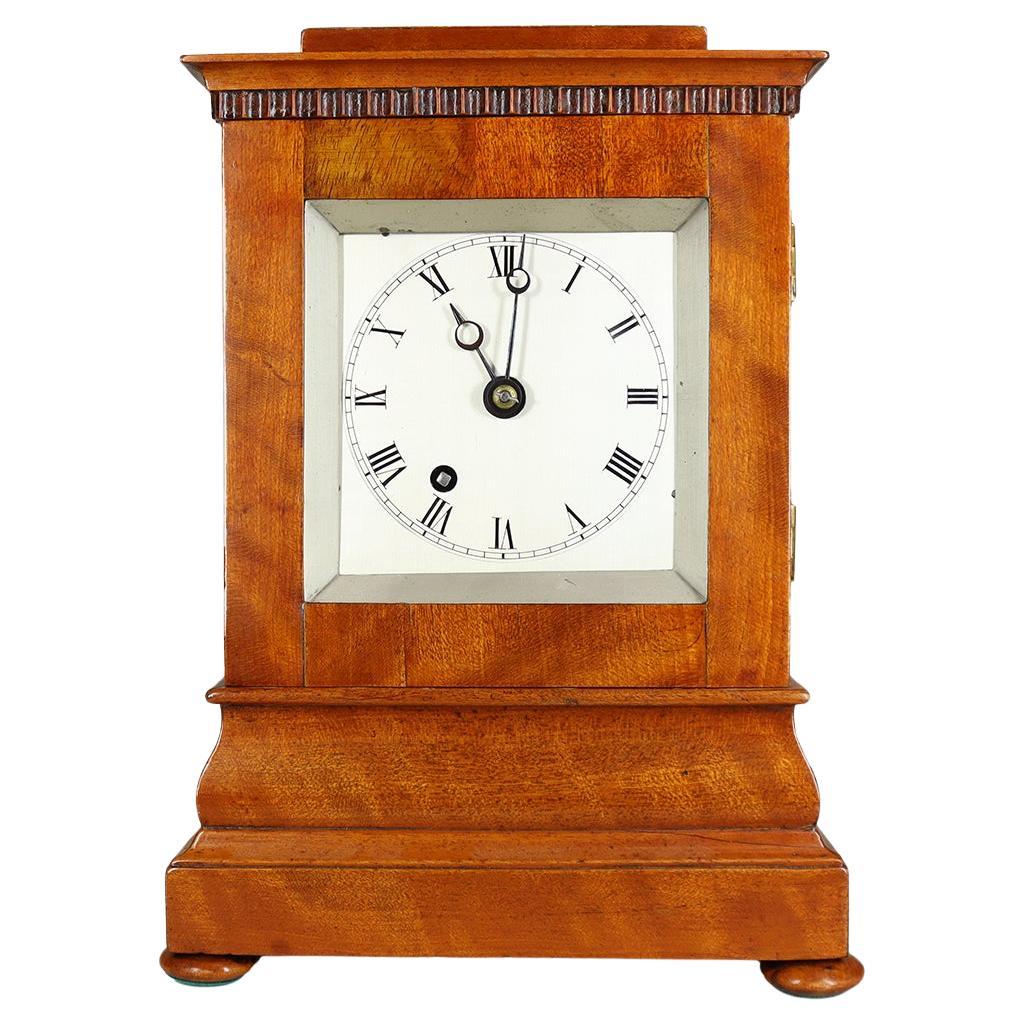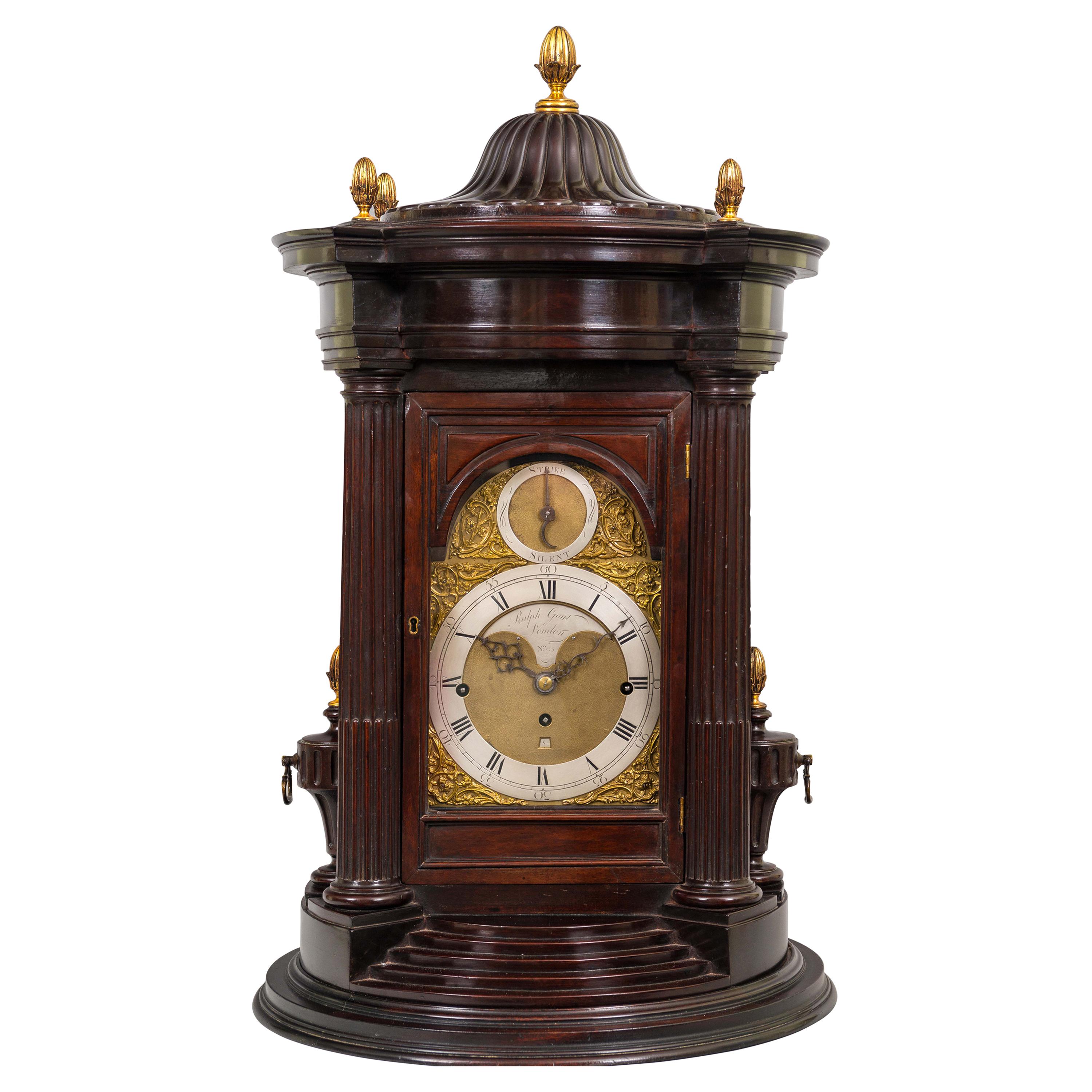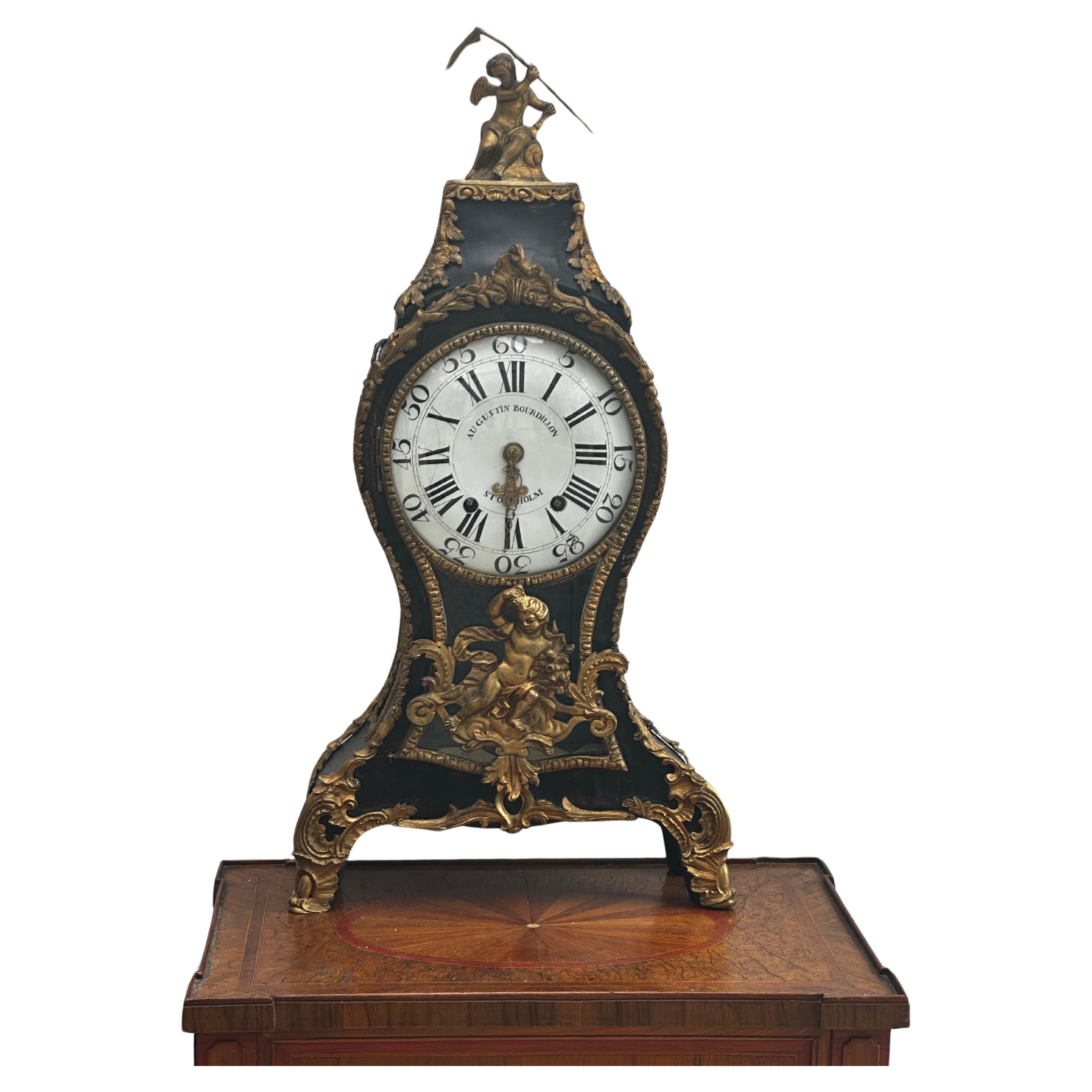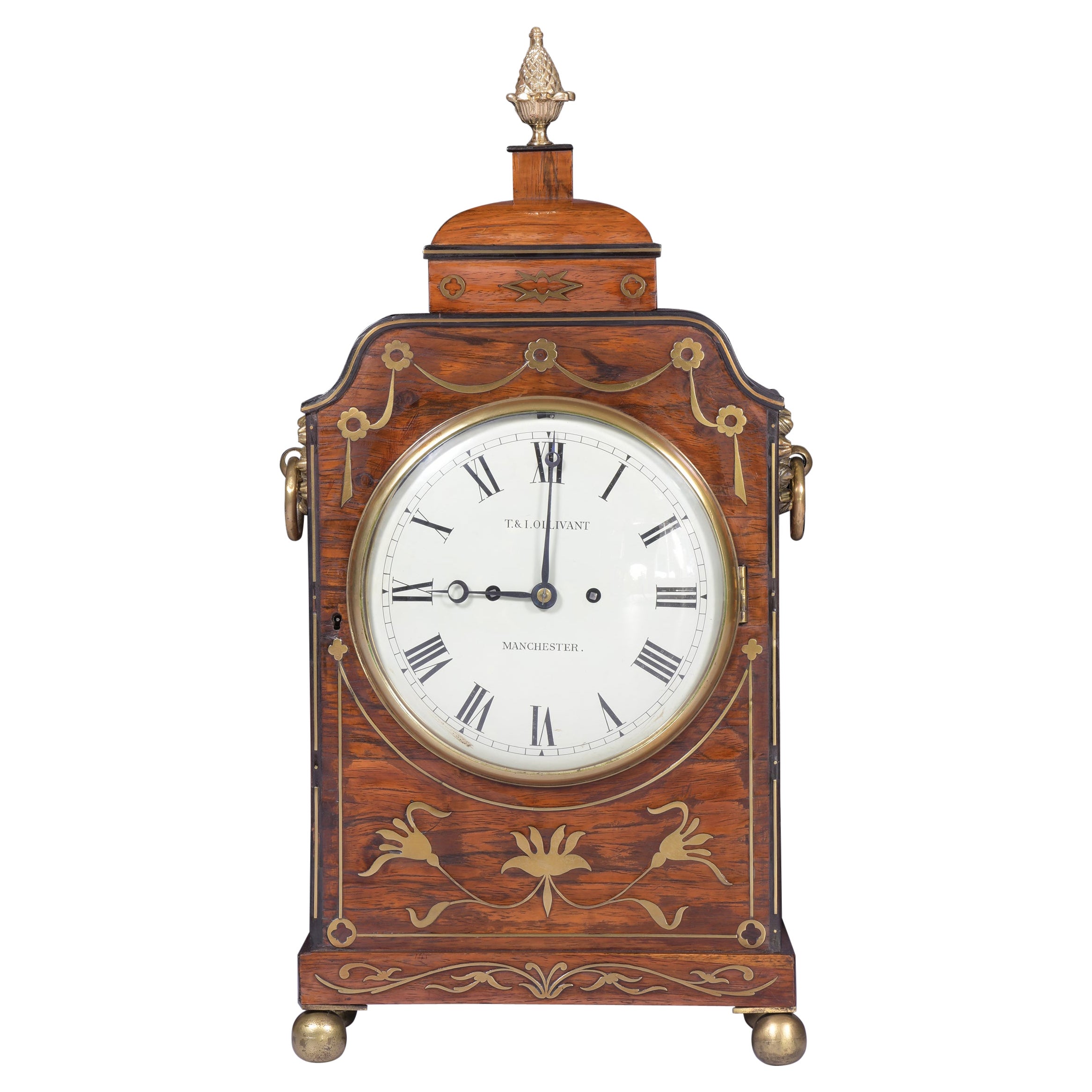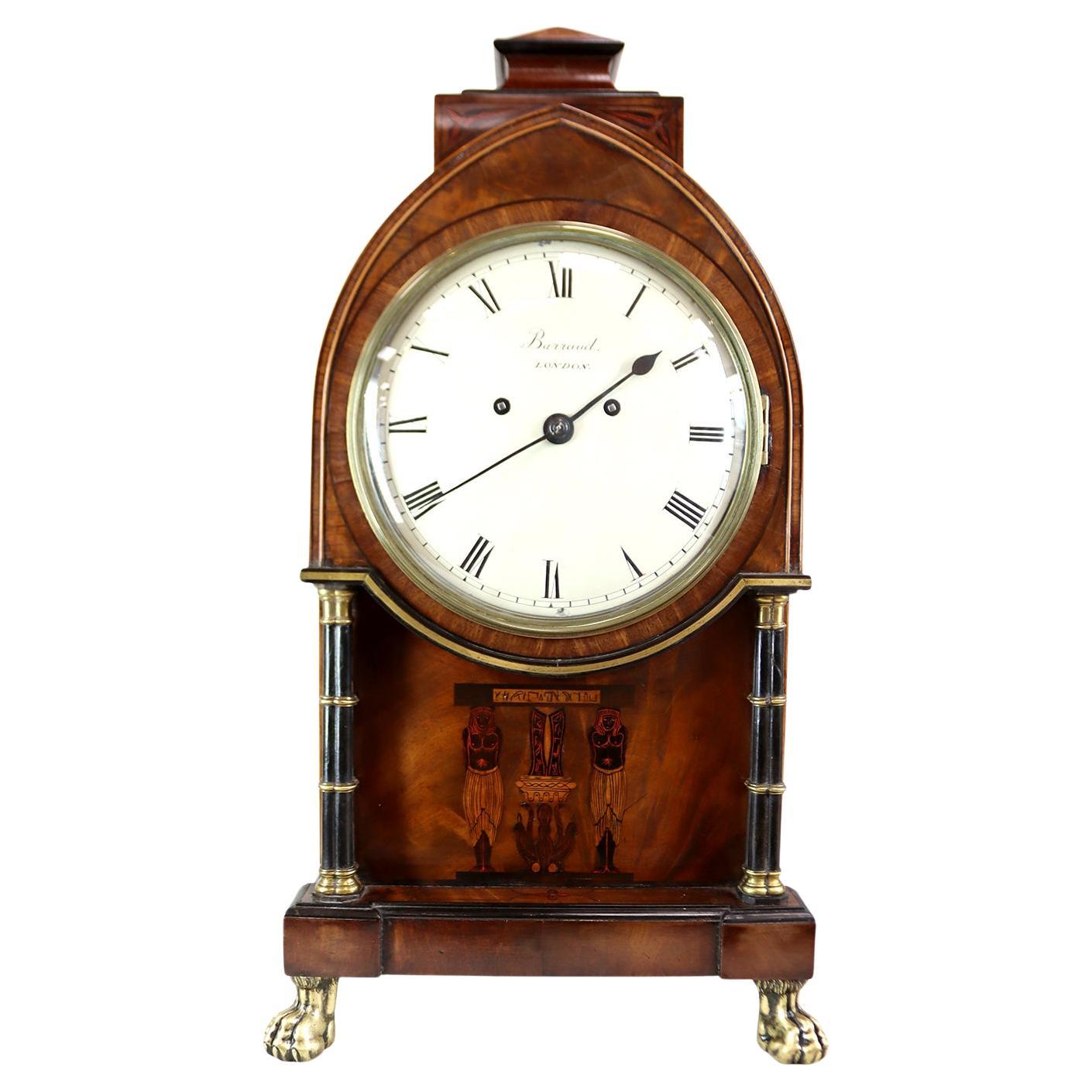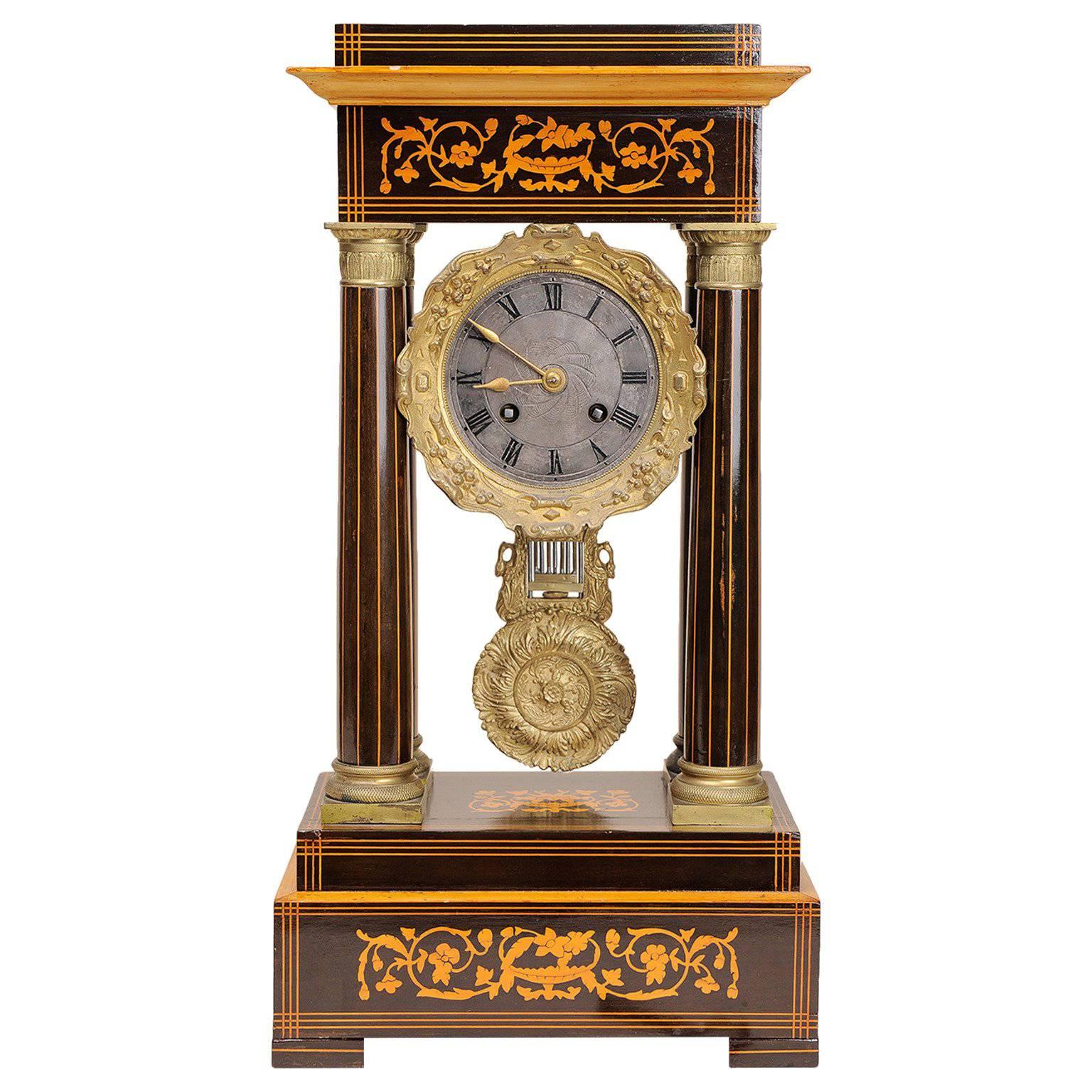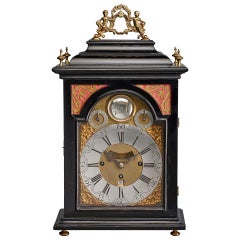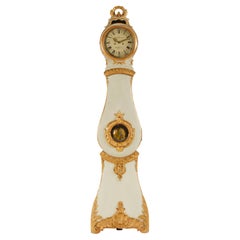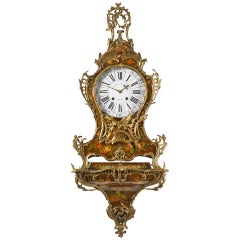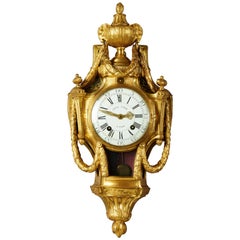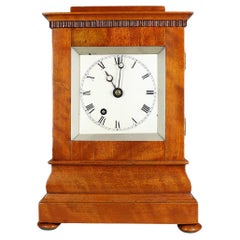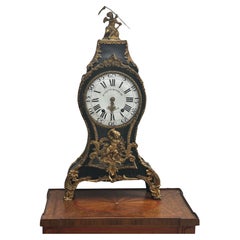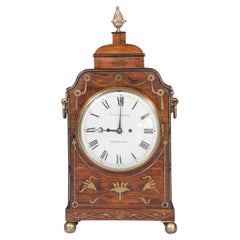Items Similar to Important German Neoclassical Table Clock by David Roentgen
Want more images or videos?
Request additional images or videos from the seller
1 of 7
Important German Neoclassical Table Clock by David Roentgen
$106,895.07
£79,253.18
€89,000
CA$146,848.71
A$160,309.37
CHF 84,404.88
MX$1,920,320.08
NOK 1,079,507.37
SEK 985,608.18
DKK 678,147.69
About the Item
An important and rare table clock from the workshop of David Roentgen. The case with an oval stepped plinth top with gilt bronze handle, decoration of the case with ormolu mille raie banding, beaded edges and brass fluted columns to the front flanking the square brass dial, foliate engraved spandrels to the corners, centred by the white enamel Arabic chapter ring, signed Delolme, pierced brass hands, convex glazed bezel, square plated eight-day movement with four back-pinned pillars, verge escapement, silk suspension, rack and count wheel strike, striking the hours and quarters on two bells above, the back plate also signed, glazed side panels.
There is only a small series of comparable table clocks from the workshop of David Roentgen known. The present clock seems to be the first example of the cooperation between David Roentgen and the court clockmaker Delolme in Brunswick. The case is meticulously crafted and both case and movement are of superb quality.
David Roentgen, called the "most celebrated ébéniste in Europe" by his contemporaries, was a successful entrepreneur who transformed the business founded by his father, Abraham Roentgen, from a national to an international firm with clients in France, Germany, England, and Russia.
- Creator:David Roentgen (Cabinetmaker)
- Dimensions:Height: 17.01 in (43.2 cm)Width: 10.63 in (27 cm)Depth: 6.11 in (15.5 cm)
- Style:Neoclassical (Of the Period)
- Materials and Techniques:
- Place of Origin:
- Period:
- Date of Manufacture:1785-1790
- Condition:Wear consistent with age and use.
- Seller Location:Worpswede / Bremen, DE
- Reference Number:Seller: 18851stDibs: LU981418387572
About the Seller
5.0
Recognized Seller
These prestigious sellers are industry leaders and represent the highest echelon for item quality and design.
Established in 1979
1stDibs seller since 2013
28 sales on 1stDibs
Typical response time: 1 hour
- ShippingRetrieving quote...Shipping from: Worpswede / Bremen, Germany
- Return Policy
More From This Seller
View AllAustrian 18th Century Baroque Period Bracket Clock, Signed Andreas Hohenadl
Located in Worpswede / Bremen, DE
An attractive Austrian mid-18th century Baroque period quarter-striking bracket clock by the maker Andreas Hohenadl (1714-1793), Vienna. The ebonised fruitwood case with figurative b...
Category
Antique Mid-18th Century Austrian Baroque Clocks
Materials
Brass
$8,407 Sale Price
21% Off
Swedish Rococo Longcase Clock signed Petter Södermann Stockholm
Located in Worpswede / Bremen, DE
Very decorative and fine rococo longcase clock by the renowned clockmaker Petter Södermann Stockholm (1740-1813). Finely carved case with scroll and shellwork gilded and painted in a...
Category
Antique 1770s Swedish Rococo Grandfather Clocks and Longcase Clocks
Materials
Wood
Rare French 18th Century Louis XV Vernis Martin Cartel Clock by Festeau le Jeune
Located in Worpswede / Bremen, DE
The clock case decorated overall with very fine ‘Vernis Martin’ lacquer paint with floral sprays and garlands. The waisted case with pierced foliate bronze mounts and surmounted by a foliate finial with a bird. On scroll feet, the bracked conformingly mounted and decorated with a scene with dogs. A fine three week going movement, striking half and full hours on a silvered bronze bell. Festeau Le Jeune became master in 1769. Clock case and bracket are stamped by the ebenist ‘A. Gosselin’ (Antoine Gosselin 1731-1794, Paris, master in 1752), as well as the stamp of the Parisian gilt ‘JME’.
In French interior design, Vernis Martin is a type of lustrous lacquer substitute widely used in the 18th century to decorate a wide variety of items from furniture and coaches to such personal articles as fans and snuffboxes. The technique was named after the French brothers Guillaume and Etienne-Simon Martin, who perfected the process, but covers work by other craftsmen as well. Highly praised by Voltaire, it was developed to imitate East Asian lacquerware...
Category
Antique 18th Century French Louis XV Clocks
Materials
Bronze
Late 18th Century, French Louis XVI Neoclassical Ormolu Gilt Bronze Cartel Clock
Located in Worpswede / Bremen, DE
A very fine Louis XVI period ormolu striking cartel clock “aux guirlandes”, the movement signed on the white enamel by Gille L’Aine, Paris. Pierre II. Gille l’ainé (1723-1784) was th...
Category
Antique Late 18th Century French Louis XVI Wall Clocks
Materials
Bronze, Enamel
Rare Late 18th Century Neoclassical Louis XVI Ormolu Mantel Clock
Located in Worpswede / Bremen, DE
The circular white-enameled dial signed ”Detour Paris” with Roman hours and Arabic quarter marks, a further inner Arabic chapter ring for the day of month. Pierced gilt hands and a b...
Category
Antique Late 18th Century French Neoclassical Mantel Clocks
Materials
Marble, Bronze, Enamel
French Early 19th Century Empire Gilt Bronze Mantel Clock by Claude Galle
By Claude Galle
Located in Worpswede / Bremen, DE
Claude Galle, (1759–1815, master in 1786) is one of the most renowned bronziers active during the Napoleonic period, such as Pierre-Philippe Thomire, André-Antoine Ravrio and Louis-S...
Category
Antique Early 1800s French Empire Mantel Clocks
Materials
Marble, Bronze
You May Also Like
A Very Fine Regency Library Clock
Located in Amersham, GB
This eight day single fusee library timepiece is of unusually small proportions, the a four pilars holding the two thick brass plates. The movement with anchor escapement has an adju...
Category
Antique 1830s English Regency Table Clocks and Desk Clocks
Materials
Brass, Steel
18th Century Antique Mahogany Neoclassical Musical Clock by Ralph Gout of London
Located in Devon, GB
An impressive and unique 18th centur,y, GeorgeIII period antique circular mahogany musical table clock, in a case of neoclassical design by Ralph ...
Category
Antique Late 18th Century English Neoclassical Table Clocks and Desk Clocks
Materials
Brass
Late 19th Century table clock, made in Stockholm by Auguste Bourdillon
Located in SE
A table clock made in Stockholm by Auguste Bourdillon, 1728- 1799. He were a manufacturer of clocks and watches in Geneva and then in Stockholm 1761 - 1...
Category
Antique 1770s Swedish Rococo Table Clocks and Desk Clocks
Materials
Bronze
Early 19th Century English Regency Bracket Clock by T. & J. Ollivant
By Thomas Ollivant
Located in Dublin, IE
A very fine English regency period bracket clock with rosewood case, surmounted by a pineapple finial on a bell shaped caddy over a double steeped plinth . Substantial 8 Day twin fusee movement striking the hours on original bell. The 8? painted enamel convex dial...
Category
Antique Early 19th Century English Regency Mantel Clocks
Materials
Brass
A Paul Philip Barraud Bracket Clock in the manner of Thomas Hope
Located in Amersham, GB
A very striking twin fusee bracket clock in an Egyptian revival style case by Paul Philip Barraud. The eight day movement with unusual round plates of thick brass engraved on the bac...
Category
Antique Early 1800s English Egyptian Revival Mantel Clocks
Materials
Brass, Steel
French Portico Clock in Rosewood and Satinwood
Located in Alessandria, Piemonte
Antique and elegant French clock, with bronze details and fine inlaid wood, perfectly working. Perfect in a studio room. It's the typical clock of European noble houses...
Category
Antique Mid-19th Century French Napoleon III Table Clocks and Desk Clocks
Materials
Wood
More Ways To Browse
Antique German Desk
Small Clock
Verge Escapement
18th Century German Table
Antique German Table Clocks
Small Table Clock
18th Century German Clock
Traveling Desk
Art Deco Black And Chrome Desks
Antique Swiss Clock
Antique Brass Table Clock
Crystal Palace Antique
Vintage Alarm Clock
Vintage Enamel Clock
Brass Art Deco Clock
Swiss Antique Clocks Swiss Antique Clocks
Art Deco 1930s Clock
Crystal Clocks
